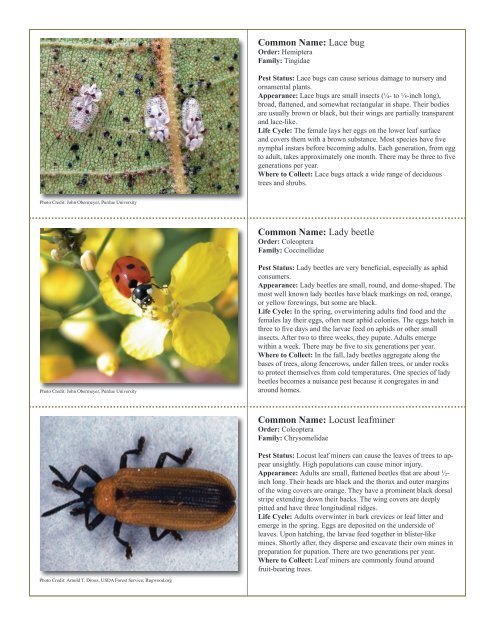to download pdf - Purdue Extension Entomology - Purdue University
to download pdf - Purdue Extension Entomology - Purdue University
to download pdf - Purdue Extension Entomology - Purdue University
You also want an ePaper? Increase the reach of your titles
YUMPU automatically turns print PDFs into web optimized ePapers that Google loves.
Common Name: Lace bug<br />
Order: Hemiptera<br />
Family: Tingidae<br />
Pest Status: Lace bugs can cause serious damage <strong>to</strong> nursery and<br />
ornamental plants.<br />
Appearance: Lace bugs are small insects (¼- <strong>to</strong> 1 ⁄8-inch long),<br />
broad, flattened, and somewhat rectangular in shape. Their bodies<br />
are usually brown or black, but their wings are partially transparent<br />
and lace-like.<br />
Life Cycle: The female lays her eggs on the lower leaf surface<br />
and covers them with a brown substance. Most species have five<br />
nymphal instars before becoming adults. Each generation, from egg<br />
<strong>to</strong> adult, takes approximately one month. There may be three <strong>to</strong> five<br />
generations per year.<br />
Where <strong>to</strong> Collect: Lace bugs attack a wide range of deciduous<br />
trees and shrubs.<br />
Pho<strong>to</strong> Credit: John Obermeyer, <strong>Purdue</strong> <strong>University</strong><br />
Common Name: Lady beetle<br />
Order: Coleoptera<br />
Family: Coccinellidae<br />
Pho<strong>to</strong> Credit: John Obermeyer, <strong>Purdue</strong> <strong>University</strong><br />
Pest Status: Lady beetles are very beneficial, especially as aphid<br />
consumers.<br />
Appearance: Lady beetles are small, round, and dome-shaped. The<br />
most well known lady beetles have black markings on red, orange,<br />
or yellow forewings, but some are black.<br />
Life Cycle: In the spring, overwintering adults find food and the<br />
females lay their eggs, often near aphid colonies. The eggs hatch in<br />
three <strong>to</strong> five days and the larvae feed on aphids or other small<br />
insects. After two <strong>to</strong> three weeks, they pupate. Adults emerge<br />
within a week. There may be five <strong>to</strong> six generations per year.<br />
Where <strong>to</strong> Collect: In the fall, lady beetles aggregate along the<br />
bases of trees, along fencerows, under fallen trees, or under rocks<br />
<strong>to</strong> protect themselves from cold temperatures. One species of lady<br />
beetles becomes a nuisance pest because it congregates in and<br />
around homes.<br />
Common Name: Locust leafminer<br />
Order: Coleoptera<br />
Family: Chrysomelidae<br />
Pest Status: Locust leaf miners can cause the leaves of trees <strong>to</strong> appear<br />
unsightly. High populations can cause minor injury.<br />
Appearance: Adults are small, flattened beetles that are about ½-<br />
inch long. Their heads are black and the thorax and outer margins<br />
of the wing covers are orange. They have a prominent black dorsal<br />
stripe extending down their backs. The wing covers are deeply<br />
pitted and have three longitudinal ridges.<br />
Life Cycle: Adults overwinter in bark crevices or leaf litter and<br />
emerge in the spring. Eggs are deposited on the underside of<br />
leaves. Upon hatching, the larvae feed <strong>to</strong>gether in blister-like<br />
mines. Shortly after, they disperse and excavate their own mines in<br />
preparation for pupation. There are two generations per year.<br />
Where <strong>to</strong> Collect: Leaf miners are commonly found around<br />
fruit-bearing trees.<br />
Pho<strong>to</strong> Credit: Arnold T. Drooz, USDA Forest Service, Bugwood.org
















